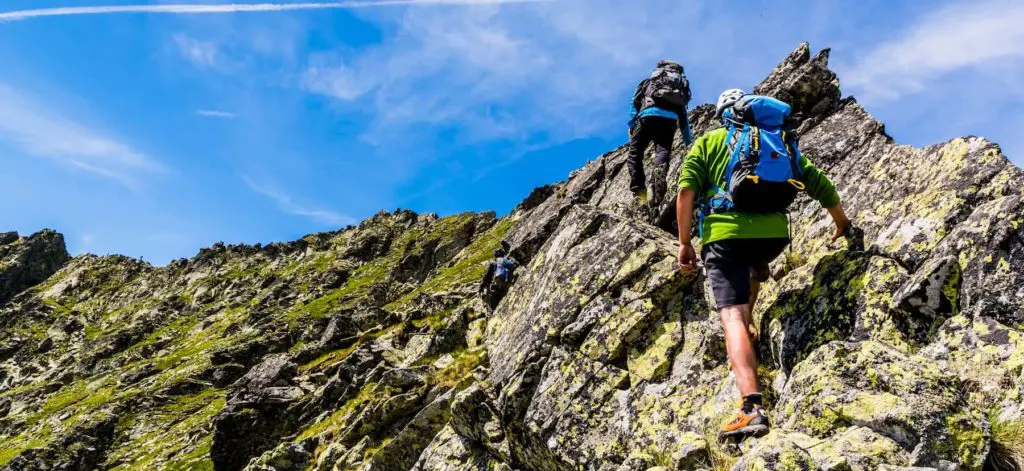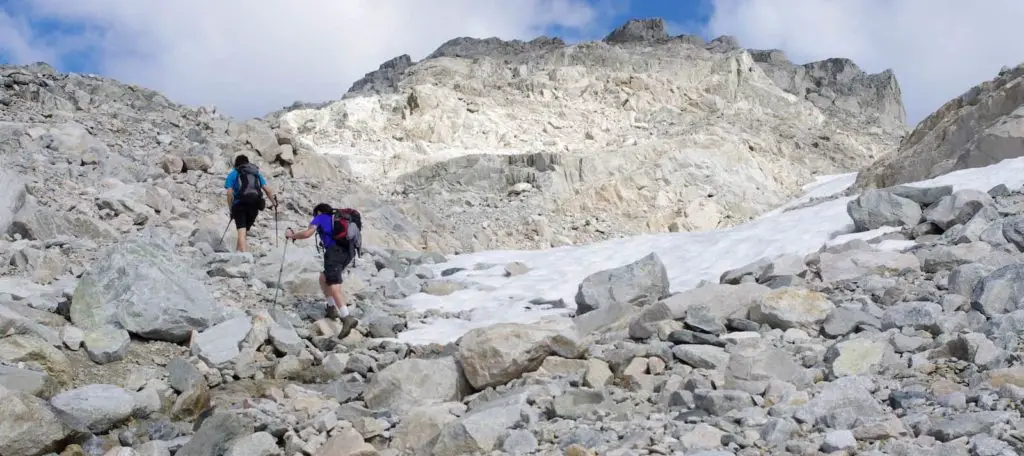Sometimes you need to scramble when you hike and many people will do this without understanding the reasons to be cautious in these attempts. This doesn’t mean that you shouldn’t attempt it, just more that it should always be weighed good and bad as to making the attempt and being successful.
What does scramble mean in hiking? Scrambling is about when the hike reaches a point where you need to climb up a steep embankment or similar large incline where you need to start using your hands to assist in keeping your balance. This typically involves using both feet and arms to manage your balance, both up and downward in travel.
Now that you understand what scrambling is, let’s jump into the reasons why it can be valuable to speeding your trip and how to take better care and safety into your approach. Now we can dive into what does scramble mean in hiking terms.
What is Scrambling?
Wikipedia and Google define it as making your way quickly or awkwardly up a steep gradient or over rough ground by using one’s hands as well as one’s feet.
If you need your hands to make headway, you’re scrambling.
Basically as soon as you convert from hiking to needing your hands to support your movement you have converted to scrambling. When you see this developing you should stop and take the whole part in your head and break it down, you want to make sure you understand a limitation or issue before it occurs.
Is Scrambling Dangerous?
Inherently humans tend to be at a disadvantage when they are required to use all 4 appendages to maintain control as they have the least practice in this style of movement. Most times when you move from leg only travel into needing all four limbs this can lead to issues if you don’t have experience and skill in them before attempting.
- Picking the Right Line – Think of this similar to walking in a downtown area. The right line when travelling in a city is the sidewalk, the place where you are clear and safe from harm as much as possible. Picking the right line on a scramble is similar, you are trying to find the path that has the least amount of downsides and the safest possible travel.
- Identifying Loose Rocks or Snow Pack – When on rocks you want to try and identify the footholds that could or will break off before you apply your weight to them, in snow, this can also apply to previous hiker steps and/or just loose snowpack. The danger is in your footing being lost as you typically will incur a fall if you should lose your footing.
- Identifying Safety Concerns Within The Route – This is one of the most important things you will need to learn to be an effective scrambler. You need to be able to look at each section of the scramble and find where your safety is at risk, where you would expect problems and then you need to think out how to handle them in advance for your own, and others, safety.
- Exposure to Heights – The last and frequently worst concern for many is exposure to heights while scrambling. Many people will choose a worse scramble if it looks like it has less exposure believing it to be “safer”, understand conditions and exposure to know how you would handle these events before you experience them!

Why Choose To Scramble?
In many cases, the reason that a scramble is chosen is that it is the best route forward and isn’t a large danger to yourself or others. In many cases a scramble could save hours of hiking up and down terrain, this is a major reason why people will choose to scramble.
Tips On Preparing To Scramble
Now we will cover preparing yourself to scramble safely and effectively.
- Pack Heavy Gear Close To Your Body – Don’t tie anything outside your pack such as swinging water bottles and sleeping pads as these can throw off your center of gravity.
- Stash the Trekking Poles – I promise you your hands are much more valuable free of the poles during your ascent.
- Ask Yourself Some Safety Questions On Your Route
- If it gets tricky is there an obvious or easy way out?
- How much pain or injury would occur should you fall?
- Are you capable of stopping your fall fast (fewer than a few feet) should you slip?
- How hurt would you get if you fell
- 3 Points Of Contact At All Times – You must maintain three points of contact at all times on steep terrain, this means one foot and two hands or 2 feet and one hand.
- Validate Your Footing – You need to test each step before committing your full weight to ensure no break or drop out occurs under your feet.
- Learn to Trust Your Feet – You want to maximize the friction between rubber and rock by keeping your center of gravity low, placing your foot flat with most of the rubber touching, and seeking bare, dry rock.
- For Your Descent – You should take out a trekking pole to use for additional balance, and while facing out, shift your weight back toward the slope to prevent falling forward.
- For Tricky Or Complex Descents – Turn and face the rock to have a more efficient grip purchase, which will also keep your pack from bumping the rock.

Benefits To Scrambling
While it may be cause for caution scrambling does have many benefits that will help you make your way faster and more efficiently. These include better management of your personal enjoyment and excitement, many times the reason you are on a trek into the unknown is exactly what you need.
Drawbacks to Scrambling
Like the reasons to take the chance and make the scramble you do take risks that can be severe overall if not played out correctly. There are many issues that can happen, the worst of which are things like falls, or accidentally breaking something.
Final Thoughts on What Does Scrambling Mean to a Hiker
By no means am I a scrambling expert but I do wish that everyone knows the ins and outs to scramble safely. I love the challenge and thankfully I am not scared or nervous in heights, but this is something that you should try to know about yourself before you are on the trail and need to use these skills.
Hopefully, you learned some useful or at least helpful information today which will help you on your next big hike, this comes in particularly helpful in places like the PCT where you climb passes sometimes which are steep or towards the end of the AT where you have numerous climbs where you need to maintain your focus to be safe and the CDT.

